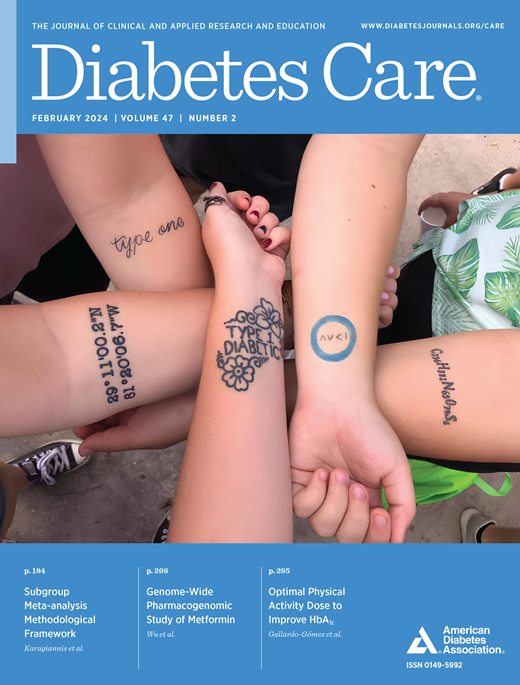Large-Scale Plasma Proteomics Improves Prediction of Peripheral Artery Disease in Individuals With Type 2 Diabetes: A Prospective Cohort Study
IF 16.6
1区 医学
Q1 ENDOCRINOLOGY & METABOLISM
引用次数: 0
Abstract
OBJECTIVE Peripheral artery disease (PAD) is a significant complication of type 2 diabetes (T2D), yet the association between plasma proteomics and PAD in people with T2D remains unclear. We aimed to explore the relationship between plasma proteomics and PAD in individuals with T2D, and assess whether proteomics could refine PAD risk prediction. RESEARCH DESIGN AND METHODS This cohort study included 1,859 individuals with T2D from the UK Biobank. Multivariable-adjusted Cox regression models were used to explore associations between 2,920 plasma proteins and incident PAD. Proteins were further selected as predictors using least absolute shrinkage and selection operator (LASSO) penalty. Predictive performance was assessed using Harrell's C-index, time-dependent area under the receiver operating characteristic curve, continuous/categorical net reclassification improvement, and integrated discrimination improvement. RESULTS Over a median follow-up of 13.2 years, 157 incident PAD cases occurred. We observed 463 proteins associated with PAD risk, primarily involved in pathways related to signal transduction, inflammatory response, plasma membrane, protein binding, and cytokine-cytokine receptor interactions. Ranking by P values, the top five proteins associated with increased PAD risk included EDA2R, ADM, NPPB, CD302, and NPC2, while BCAN, UMOD, PLB1, CA6, and KLK3 were the top five proteins inversely associated with PAD risk. Incorporating 45 LASSO-selected proteins or a weighted protein risk score significantly enhanced PAD prediction beyond clinical variables alone, reaching a maximum C-index of 0.835. CONCLUSIONS This study identified plasma proteins associated with PAD risk in individuals with T2D. Adding proteomic data into the clinical model significantly improved PAD prediction.大规模血浆蛋白质组学改善2型糖尿病患者外周动脉疾病的预测:一项前瞻性队列研究
外周动脉疾病(PAD)是2型糖尿病(T2D)的重要并发症,但血浆蛋白质组学与T2D患者PAD之间的关系尚不清楚。我们旨在探讨血浆蛋白质组学与T2D患者PAD之间的关系,并评估蛋白质组学是否可以改善PAD风险预测。研究设计和方法本队列研究纳入了1859例来自英国生物银行的T2D患者。采用多变量校正Cox回归模型探讨2920种血浆蛋白与PAD发病之间的关系。使用最小绝对收缩和选择算子(LASSO)惩罚进一步选择蛋白质作为预测因子。采用Harrell’sc指数、受试者工作特征曲线下的时间依赖面积、连续/分类净再分类改进和综合判别改进来评估预测性能。结果在13.2年的中位随访中,发生了157例PAD病例。我们观察到463种与PAD风险相关的蛋白,主要参与与信号转导、炎症反应、质膜、蛋白结合和细胞因子-细胞因子受体相互作用相关的途径。按P值排序,与PAD风险增加相关的前5个蛋白为EDA2R、ADM、NPPB、CD302和NPC2,与PAD风险负相关的前5个蛋白为BCAN、UMOD、PLB1、CA6和KLK3。结合lasso选择的45种蛋白质或加权蛋白质风险评分显著提高了PAD的预测,超过了单独的临床变量,c指数最高为0.835。结论:本研究确定了与T2D患者PAD风险相关的血浆蛋白。将蛋白质组学数据添加到临床模型中可显著提高PAD的预测。
本文章由计算机程序翻译,如有差异,请以英文原文为准。
求助全文
约1分钟内获得全文
求助全文
来源期刊

Diabetes Care
医学-内分泌学与代谢
CiteScore
27.80
自引率
4.90%
发文量
449
审稿时长
1 months
期刊介绍:
The journal's overarching mission can be captured by the simple word "Care," reflecting its commitment to enhancing patient well-being. Diabetes Care aims to support better patient care by addressing the comprehensive needs of healthcare professionals dedicated to managing diabetes.
Diabetes Care serves as a valuable resource for healthcare practitioners, aiming to advance knowledge, foster research, and improve diabetes management. The journal publishes original research across various categories, including Clinical Care, Education, Nutrition, Psychosocial Research, Epidemiology, Health Services Research, Emerging Treatments and Technologies, Pathophysiology, Complications, and Cardiovascular and Metabolic Risk. Additionally, Diabetes Care features ADA statements, consensus reports, review articles, letters to the editor, and health/medical news, appealing to a diverse audience of physicians, researchers, psychologists, educators, and other healthcare professionals.
 求助内容:
求助内容: 应助结果提醒方式:
应助结果提醒方式:


